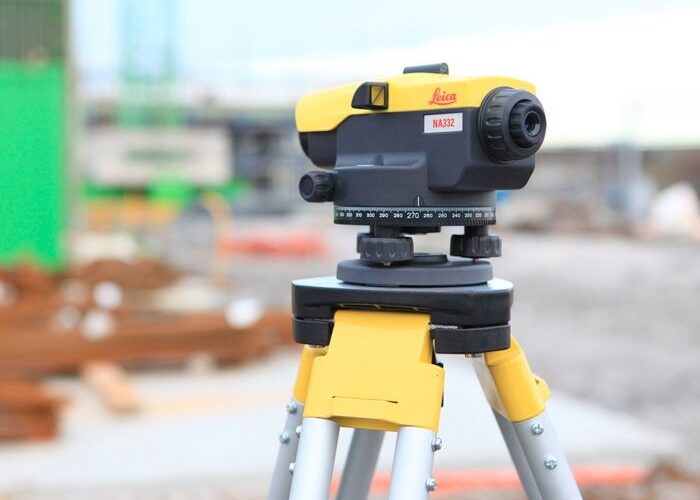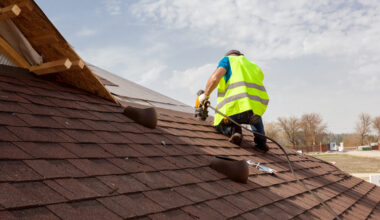Plane surveying (finding the location of structures, boundaries, and topographical features as though they were on a level surface) has a long history, dating back to the Egyptians.
The hammer is to nailing what the transit level is to plane surveying. It’s tripod-mounted optical equipment (basically a telescope) with a built-in spirit level. Read on to learn how the laser transit level works and our top options of transit levels in the market.
What is a Transit Level?
A transit level is a high-precision tool. It’s calibrated to show true horizontal as well as the angle of inclination in degrees, minutes, and seconds. A transit level is a varied and flexible tool capable of many jobs in the hands of an expert, yet some of its most fundamental applications are simple to master. As a result, anyone planning to construct a new construction will find this tool quite useful.
How Does It Work?
The transit level functions similarly to the builder’s level. To begin, you’ll need to assemble a tripod on which to put the transit level. You’ll need to adjust the leveling feet on the transit level once it’s securely secured to the tripod until the built-in level indicator reads that it’s level at every point in 360° rotation. So far, there’s no discernible difference between how a transit level works and how a builder’s level works.
However, once you’ve set up and changed the level, you’ll notice a difference. It can now be adjusted both vertically and horizontally, whereas the builder’s level can only be adjusted horizontally. You can use it to measure vertical angles while keeping the builder’s level’s elevation measuring capabilities by raising and lowering the front of the telescope.
A Transit Level’s Components
A transit level’s basic configuration includes the transit level itself, a tripod base, a tape measure, and a calibrated rod. The transit level itself is made up of several components:
| PARTS OF A TRANSIT LEVEL | |
| PART | DESCRIPTION |
| Telescope & Locking Levers | Holds lenses magnifying objects in sight |
| Detachable Sunshade | Used to block sunlight from affecting objects being sighted |
| Graduated Leveling Vial | Used to level the telescope on its base |
| Horizontal Vernier Scale | Moves around the main scale determining horizontal angular readings too small to read on the main scale |
| Graduated Horizontal Circle | Marked by degrees, used for setting and reading horizontal angles |
| Horizontal Clamp Screw | Holds the instrument in a horizontal position when tightened |
| Horizontal Tangent Screw | Can be adjusted to make the instrument move left or right on the horizontal plane |
| Graduated Vertical Circle | Marked by degrees, used for setting and reading vertical angles |
| Vertical Vernier Scale | Moves around the main scale determining vertical angular readings too small to read on the main scale |
| Leveling Screws | Allows adjustments to be made to ensure the instrument is level in all positions |
| Base-Graduated Leveling Vial | The area-level attaches to tripod – has spirit level ensuring the base is level when attaching transit level |
| Focusing Knob | Can be turned to make objects appear crisp and clear |
| Eyepiece | Located at the viewing end of the telescope, it can be turned to bring the crosshairs into focus |
| Alidade | The entire upper part of the level, including telescope and supports, leveling vials, spindle, and circle-reading device |
Best Transit Levels on the Market
#1. DEWALT 20X Builder’s Level Package (DW090PK)
If you’re looking for a transit level for sale that gives you the most bang for your buck, the DEWALT DW090PK 20X Builder’s Level Package is for you. This set contains a top-of-the-line DEWALT builder’s level, a tripod, and an 8-foot grade rod, which is fantastic. This bundle is unquestionably the solution to your leveling issues!
This model is deserving of the top spot in our selection of the finest transit levels for 2022. It’s reasonably priced, and evaluations indicate that it’s well worth the money. Furthermore, users claim that this transit level is well-built and produces precise results. It’s ideal for professional use while remaining cheap for home use.
This DEWALT transit level has a 1/4-inch per 100-foot precision and a 360-degree horizontal circle with a vernier scale to prove its accuracy and quality. Over a 200-foot working range, it also magnifies target objects 20 times. This transit level for sale can give you precise horizontal angles, level lines, and heights thanks to these qualities.
This comes with a covered leveling vial and a heavy-duty leveling base for quick and level setups—parts that are engineered to resist hard job site conditions.
Features
- 8′ aluminum grade rod, DEWALT builder’s level, and aluminum tripod
- 1:100 stadia ratio, a 360-degree horizontal circle with a vernier scale, shielded leveling vial, heavy-duty leveling base
- Magnification – 20x
- Range of operation – 200’
- Accuracy – a quarter “per 100′ precision
- Warranty – Limited warranty of three years
#2. Self-Leveling Cross-Line Laser Transit Level Kit by Johnson Level 40-0921
This Johnson Level kit can provide good value for money for applications that require both horizontal and vertical leveling at the same time. It includes one cross-line laser level, an elevating tripod, tinted glasses, and a hard-shell carrying box, as well as all the necessary instruments for leveling jobs.
Self-leveling, the laser transit level can be used with or without a tripod. Because of its working range of up to 100 feet, it is ideal for projects in small to large indoor environments. According to several users, the laser’s light intensity is ideal for outdoor applications. If not, the tinted glasses should aid in better seeing of the laser lines.
Another aspect that purchasers appreciate about this Johnson Level instrument is its ease of use. Turn the power knob, place the laser transit level on the tripod, and then fix the angles using the protractor scale on the laser’s base to complete the setup. The angle can be set anywhere between zero and 360 degrees depending on the task.
The level is also ideal for working in difficult conditions. It’s IP54 casing effectively protects against dirt, oil, moisture, and other corrosive materials found in one’s work environment.
Features
- A cross line laser level, a 47′ telescoping tripod, tinted glasses, a hard-shell carrying bag, and a handbook are all included with the Johnson Level cross line laser transit level.
- IP54 enclosure, self-leveling pendulum, Class Illa laser, and hard-shell case locking mechanism
- Range of operation – 100’
- Accuracy – a quarter “at the 35′
- Warranty – Manufacturer’s 3-year warranty
#3. NSLP500B Siteline Transit Level Package from NWI
Another Northwest Instrument Siteline Transit Level has made it onto this list of the finest transit levels for 2022, and for good reason. While the NWI NSLP500B is a little more expensive than the first Siteline transit level on the list, it comes with a unique feature: +/- 45-degree transit capabilities. Because of this, the NSLP500B is suitable for obtaining precise vertical angles.
In addition to recording vertical angles, it can also take horizontal readings. It has a horizontal circle with a vernier scale and a vertical and horizontal precision of 1/4 inch at 100 feet, allowing for exact vertical and horizontal measurements.
You won’t have any trouble seeing readings up to 200 feet away thanks to the multi-layer coated lens covered by a rubber lens jacket, as well as the 20x magnification and stadia lines. Furthermore, it is protected by IP54 housing, making it both water and dust-resistant.
This transit level is popular among hobbyists and land surveyors alike for various construction activities like erecting fences and verifying elevations. It works well and is simple to set up. It’s not surprising, given its continuous tangent drive, which allows for quick and seamless functioning.
Features
- The Siteline transit level comes with an aluminum tripod, a 9′ aluminum grade rod, a carrying box, a plumb bob, and a user handbook.
- Leveling screws, continuous tangent drive, horizontal circle with vernier scale, multi-layer coated lens, rubber lens jacket, IP54 enclosure, +/- 45-degree transit capability, crosshairs with 1:100 stadia lines, leveling screws, continuous tangent drive, a horizontal circle with a vernier scale, multi-layer coated lens, rubber lens jacket
- Magnification – 20x
- Range of operation – 200’
- Accuracy – a quarter “at 100 ft
- Warranty – Manufacturer’s 3-year warranty
#4. Builder’s Level Transit System 40-6912 22X Johnson Level and Tool
The Johnson and Tool 40-6912 Builder’s Level is a good choice of transit level package for grading and leveling activities. A contractor-quality tripod, a 13-foot aluminum grade rod, and a hard-shell carrying bag are included in this kit, in addition to the Johnson transit level. Customers like that the entire package satisfies their needs for construction projects.
A graduated horizontal circle with a vernier scale is featured on this transit level. While some customers complain that the scale is difficult to align, it nonetheless offers consumers direct 15-minute readings. In addition, the transit level has a vertical arc that measures vertical angles up to 45 degrees.
This transit level has a horizontal tangent screw and a vertical lock with a tangent screw for precise vertical and horizontal readings. The big size of these leveling screws makes them easy to spin and adjust. The Johnson transit level has a built-in sunshade for clear sighting in bright sunlight, as well as a level vial attached on the top for simple viewing and level settings.
Features
- A hard-shell carrying box, a Johnson transit level, a contractor-grade metal tripod, and a 13′ aluminum grade rod
- Vertical arc, horizontal tangent screw, vertical lock, and tangent screw graduated horizontal circle with a vernier scale, built-in sunshade, graduated horizontal circle with a vernier scale, vertical arc, horizontal tangent screw, vertical lock, and tangent screw
- Magnification – 22x
- Minimum Concentration – 4′
- Accuracy – ±3/16″/100′
- Warranty period: 3 years
#5. DEWALT DW092PK 20X Transit Level Package
With the correct equipment for the job, such as the DEWALT DW092PK Transit Level Package, working on elevations can be done with accuracy and efficiency. A transit level, aluminum tripod, 8-foot aluminum grade rod, and carrying bag are included in this package, which can be used for grading and other construction jobs.
The DEWALT transit level is well-liked by users because of its high quality and low cost. Although some users experience difficulty leveling at first, following the initial leveling, using this transit level can be a breeze. Because the transit level features a horizontal circle with a vernier scale and a continuous tangent drive for smooth adjustments, this is the case.
This transit level also comes with a covered vial and a heavy-duty leveling base for level and sturdy settings. It can also deliver accurate vertical angle readings because it has a transit capability.
This transit level, like the others on the list, has a working range of 200 feet and can magnify target points 20 times. It also has a 1/4-inch precision “per 100′, resulting in accurate measurements.
Features
- Transit level, aluminum tripod, 8-foot aluminum grade rod, and travel container by DEWALT
- Vertical angle transit capability, shielded leveling vial, heavy-duty leveling base, 1:100 stadia lines, continuous drive horizontal circle with a vernier scale
- Magnification – 20x
- Range of operation – 200’
- Accuracy – a quarter “for every 100′
- Warranty – Limited warranty of three years
How Do I Read a Transit Level?
- Identify the eyepiece. The crosshairs can be brought into focus by turning this.
- The leveling vial is located above the level’s scope.
- The focusing knob is located at the end of the scope.
- The horizontal graduated circle is a degree-marked circular guide used to read horizontal angles.
- Just above the horizontal graded circle is the horizontal tangent knob, which is used to adjust left and right.
- The vertical tangent knob is on the right side of the scope, on the near side, and is used to adjust up and down.
- The vertical direction is locked in place by the vertical lock knob, which is just past.
- Just below the horizontal graduated circle are the leveling screws. To keep the device level, these can be changed.
- A detachable sunshade is available on some levels to shield sunlight from the lens.
Setting Up a Transit Level
- Take the level out of its carrying case.
- Place the level on the tripod head immediately.
- The transit level should be threaded or bolted to the tripod base.
- Place the protective lens covers in the carrying case after removing them.
- Place the telescope’s sunshade on top of it.
- Your transit level has been installed.
What is the Best Way to Focus a Transit Level?
The next step is to focus the transit level after ensuring that your instrument is level at all leveling sites.
- The initial step in this procedure is to point your telescope at a specific target. The object should appear hazy, but rotating the eyepiece left or right should clear it up.
- Point the telescope directly at the target after focusing the eyepiece. Use the focusing knob to make the given object appear sharp while maintaining the crosshairs in focus. A level grade line, also known as a reference line, is a sightline determined by the use of a telescope. It’s made at the horizontal crosshair, and it takes two people to make.
Drawing a Line of Reference
- An additional worker keeps a graduated staff or tape measure vertical at the place under measurement while the operator looks through the telescope’s eyepiece.
- During site surveys and building construction, the device and crew are employed to collect or transfer elevations.
- The measurement begins with a known height benchmark or an arbitrary point with an assumed height.
Builder’s Level vs. Transit Level
Builder’s levels are extremely similar to transit levels. When a transit level’s telescope is fixed into place, it functions almost identically to a builder’s level. Between a transit level and a builder’s level, there is one major distinction. When not held in place, a transit level can only tilt vertically and has a very limited range of motion. The builder’s level, on the other hand, can move horizontally in a complete circle.
With their vertical moving mechanism, transit levels are excellent tools for measuring vertical angles. For establishing straight lines and turning angles, transit levels are preferable over other leveling equipment.
What Is The Difference Between an Optical Level and a Transit Level?
A transit level can be used to measure vertical angles and distances between parallel objects when flipped on its side. It can also be used to create a perfectly straight line. A normal Optical Level does not have the capability.
Transit Level FAQs
How accurate are transit levels?
With an accuracy of 0.0625 per 250 feet, this automatic transit level is one of the most precise optical instruments in its price range. Though we used the instrument to calculate horizontal angles and check elevations, it is also often used for other purposes.
How do you use a pool transit level?
Firmly press the legs into the soil. Carefully place the transit on the mounting plate. Turn the locking screw on the underside until it is snug. By adjusting the sliding legs or leveling screws until the bubble is exactly positioned, level the mounting plate to the center of the vial bubble.
Who invented the transit level?
Young, William J.
In the nineteenth century, transit was the most important surveying device in the United States. However, the form’s inventor, William J. Young, saw it as only a modification of his new railroad compass when he created it in 1831.
Related Articles
- SPLIT LEVEL HOUSE: Meaning, Remodeling, and Buying Guide
- BI-LEVEL HOUSE: Pros and Cons In Investing
- ENVIRONMENTAL CONSULTANT SALARY: Average Salary for Entry-Level Consultants
- SUMP PUMP MAINTENANCE: Best Tips To Make Your Pumps Last Longer
- A Guide to Sewer Scope Inspection 2023: Overview and Importance






